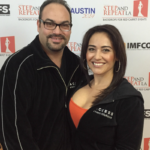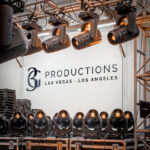Company History an Inspiring Tale of Perseverance
Spotting something on eBay triggered Eric Von Fange to think back to his earliest days as lighting director and the latest in LED technology simultaneously. He had been in the business professionally since the tender age of 17, so he’s hoisted more than a few Fresnels in his day. And as the owner of a lighting clamp and accessory company for over a quarter of a century, he’s been able to keep up with all innovations.
After some time at the workbench, he devised a revolutionary new approach that combines the best of both worlds with his LED 100W six-inch Work Light Fresnel and LED Dimming 100W Fresnel House Light.
With its link to a fascinating career that was touch-and-go on more than one occasion, today The Light Source is an established company with a reputation in the entertainment industry for quality innovative lighting products. But it all started with a kid asking a preacher for a job.
“Pat, How About a Job?”
Von Fange has had an enviable career. It’s even fair to say it’s been blessed. Born in Schenectady, NY, he attended high school in Chesapeake, VA. After graduating, he worked as a car mechanic at a local Chevy dealership. Within the first week, he had learned Important Lesson Number One: He did not want to be a mechanic. “I’m sure grateful when they fix my cars, but I knew that wasn’t for me!”
Meanwhile, he was friends with preacher Pat Robertson’s family. “We had regular prayer meetings at Pat Robertson’s house. One late night when I was leaving the TV station, he was walking down the stairs, and I said, ‘Pat, how about a job?’” Robertson said they had just lost someone the day before, and if Von Fange could start Monday, he could work the lights at his new studio.
So at the age of 17, he was working the lights for the newly-founded Christian Broadcasting Network’s first station, in Portsmouth, VA. “It wasn’t a real big staff,” he laughs. “You could fit the entire staff in a normal-sized office easily!”
He also worked other gigs, and the early days weren’t always smooth. Also at the age of 19, he was called in to light the Women’s National Bowling Championship in Irving, TX. It was a “fancy” 72-lane alley, and he learned Important Lesson Number Two — the difference between a single-phase panel and three-phase one. His roommate plugged one of the lights in and got a fine 240V howdy-do. “Instantly, the entire place filled with smoke, and glass was blown all over their pristine alleys. I was lighting the pins and ran and turned the power off … I learned what three-phase was that day!”
As a student at Oral Roberts University, he continued to hone his craft. For four years he was the head electrician for all their TV productions, and handled the lighting for all Richard and Patti Roberts touring productions. “We’d pack a 24-foot truck with lights and sound and take off, doing three or four cities in a weekend.” When he graduated, he had an offer to work for Academy Lighting Consultants in Hollywood in addition to a promise of work at ORU, CBN, and PTL. He says he prayed on it and was guided to move to Charlotte to work for the PTL network, where he would become the senior lighting director for nearly nine years.
“During this time, I was in charge of all the production lighting, as well as the design and installation of lighting in the new construction of all public oriented facilities. This included theatres, TV studios, a water park, several outdoor amphitheaters, a 600 room hotel, and even a shopping mall with moving clouds projected by day and stars by night!”
But the bulk of his time was spent working on the Jim Bakker show, which went live two hours a day every day and featured many different sets of music and variety acts. But in 1984, he decided to strike out on his own, and founded The Light Source, which would allow him to do television and theatrical lighting consulting and systems installation. “I was working with churches and ministries to improve their lighting, and had several big projects that popped up right away.”
Despite the initial flurry of work, the early days were uneven. He says his faith helped him through and, sure enough, the company got on solid footing again by the early 1990s. “We went from peanut butter and jelly sandwiches to steaks!” he laughs. “I personally was responsible for lighting three Presidential events, two NASA wind tunnel lighting designs at Langley, Home Shopping Network’s Net 1, 3 and 4 studios, and many other world-class projects.”
Into Manufacturing
Then one day he was working with a church in Jacksonville and was ordering 400 PAR 64s from a manufacturer and was told it’d save $7 per light if he’d get his own clamps. He hit on the idea of making them out of aluminum extrusion. “I cut a piece on a band saw, hooked it to a pipe, and hung 900 pounds of cable on it,” he says. “It didn’t break, didn’t even bend.”
And then his business took off in a whole new direction. By the end of 1993, “we were in the clamp business!” He would move into claws, couplers, grid and track systems, floor stands, truss accessories and related parts.
From the beginning, they operated the business out of the home. But then one day in 2006, Von Fange looked around outside. He surveyed all his family member’s cars, the cars of 15 employees and three tractor-trailers waiting for shipment, and he realized he had created his own traffic jam. “It was time to move,” he laughs.
But his timing was not so funny. Just as his operating costs increased substantially, the economy plummeted, taking 25 percent of his business with it. Again, he and his family turned to prayer. “God provided special projects, completely outside our normal products, to make up the difference. We made an aluminum I-Beam system for Atlanta Rigging Systems to manually move a 12,000-pound video wall for a show. This led to an electrically-powered trolley that would move tons with a positional accuracy of less than a third of a millimeter.” This trolley was used by the band Phish “for flying the giant hot dog over the audience at a New Year’s Eve party last year.” He adds he’s especially grateful that they didn’t have to lay anybody off, or even cut back on advertising.
Today, they work out of a 67,000-square-foot manufacturing facility in Charlotte, and almost a third of the 18 employees are Von Fange’s immediate family — his wife Joyce and three of his four kids work full-time there, with a fourth handling website duties.
In addition to all his experience in real-life and varied lighting situations, he’s learned a lot on the manufacturing side as well. And the artist has become the scientist. “I think we make better products because we have learned things about the alloys,” he says. “We have a tensile testing machine that can pull 60,000 pounds, and that allows me to put a clamp or truss hanger on it and see how strong they are. We do all that in-house, and it’s a great advantage in research and development. As far as our products, we think we make the best clamps in the world.”
Clamps to LEDs
But now The Light Source is embarking on an entirely new adventure: LED fixtures.
First came the LED 100W work light, which has a six-inch Fresnel lens. “It’s brighter than a 500W quartz light, yet the light beam is cool,” he says. It offers warm white or optional cool white light color. It has an on/off rocker switch and a 20-foot IEC to Edison power cable is included.
There’s also the 100W fully-dimming LED Pendant Down Light. This has a six-inch fresnel lens and a wide even field. It’s also brighter than a 500W quartz light and features warm white color, with 6,500 to 7,500 lumens output per fixture. Special communication chips allow up to 256 of these fixtures to run on one DMX line, instead of the typical 32.
When pointed out that the LED lighting field is pretty crowded, Von Fange doesn’t disagree. “But ours are different,” he says. “These are a point source of LEDs, so instead of red, blue, and green covering a certain space and shooting out individually points, all the light comes from one point. It is a very smooth light by comparison. Also it’s traditional — it’s a Fresnel like I have been using for 40 years. But now they don’t burn hot, and you get 500 watts out of it with just 100 watts of light going in.”
He debuted the lights just before last year’s LDI, and they are growing in popularity. One reason is they look “normal” — so they go great in older houses next to older fixtures. “Architectural engineers see them and say, ‘Hey I’m used to this!’ And they dim like traditional lights but save up to 80 percent in energy costs.”


